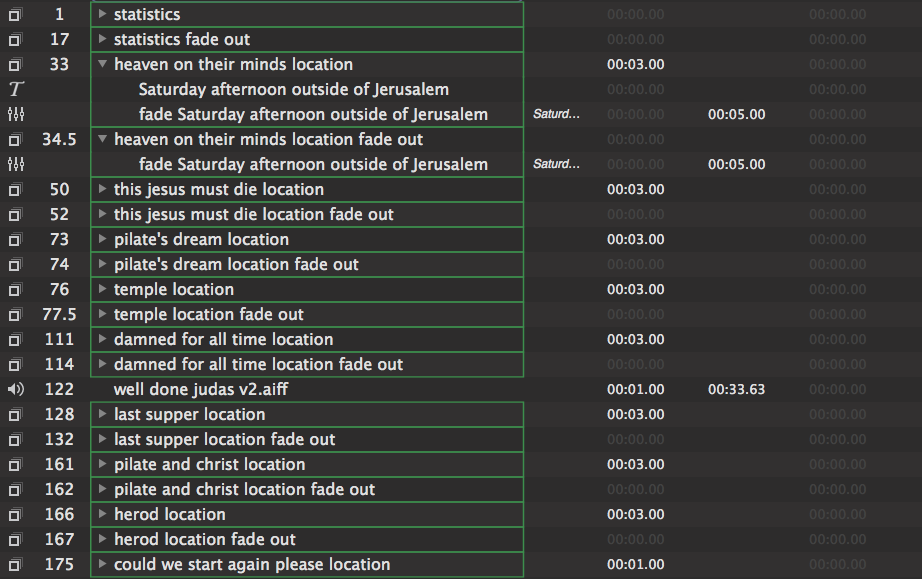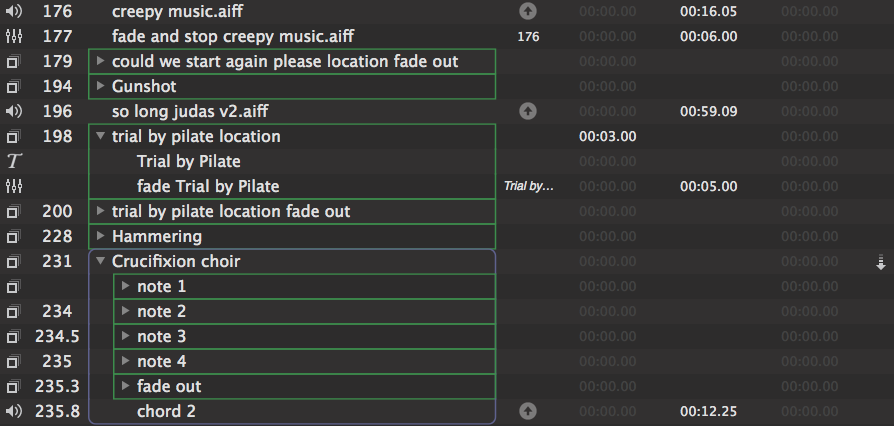Bevibel Design
Line Rider and Theater Design/Tech
Photos by Andrew Benusa Photography
Sound Highlights Reel
Sound Reinforcement Design
Vocals
- 26 Countryman B3 mic elements (various mounting methods: earpieces, elastic halos, threaded through hair)
- 4 Shure UR4D wireless receivers, 22 Shure SLX wireless receivers
- Behringer X32 (with about 25 programmed DCA scenes) for vocal mics
- Central 2-speaker cluster for vocal reinforcement
- Reverb effect used for a quasi-wail in the Overture
Band
- 7-person band in loft up offstage right
- 4 DIs (keyboard, bass, electric guitar, acoustic guitar)
- 8 mics (cello, oboe/clarinet, bassoon, flute/sax (conductor), 2 overhead drums, snare drum, kick drum)
- 12 channels on analog sound board for mixing band (feeding two output channels into Behringer X32)
- 2 speakers on either side of stage for band
Sound Effects
This sound was introduced late because it was extremely difficult for the singers to come in together backstage, and it turned out to work really well for the show. It was created by modifying a recording of the actors singing, and used at the end of Act 1 when Judas betrays Jesus (and a reprise "So long Judas" was also used in Act 2after Judas commits suicide)
How do you make a hammering sound "biblical"? Slow it down and add reverb! This was used after the glitzy "Superstar" number to bring the audience's attention back to Jesus's imminent crucifixion. The sound was mentioned in the review:
Then Danner [the director] brings both Judas and the audience back to harsh reality with the echoing sound of the hammers nailing Jesus to the cross.
To create tension and atmosphere as Jesus is raised onto the cross, I individually recorded four notes in a cluster chord from an actress in the show, and then played them back together. The notes are individually added as the cross is raised, and then when it was up this sound was played in synchronization with the lighting. The sequence was based on the score but heavily reworked.
Programming in QLab 3
- Projections programmed from a list the director provided of the times and places of scenes. Projected on the side walls of the house.
- Echo Audiofire used to run QLab cues off of ETC Element lightboard via MIDI. QLab cue numbers had to match light board cue numbers.
- Sound effects could be sent to each speaker individually.
System Diagram
Backstage Systems
Clearcom Headset Locations
- SM in booth
- Stage right & left ASMs
- Light board operator
- Flyrail operator
- Spotlight operator in house rear
- Spotlight operator on upstage midrail
- Safety beneath stage for cross mechanism
All AV Monitors
- 2 speakers on either side behind proscenium (as band monitors for actors)
- 2 small speakers in band loft (as vocal monitors)
- video feed from camera in booth to monitor in band loft (for conductor to see stage)
- video feed of conductor from camera in band loft (to two monitors in back of house and a third for the stage manager)



